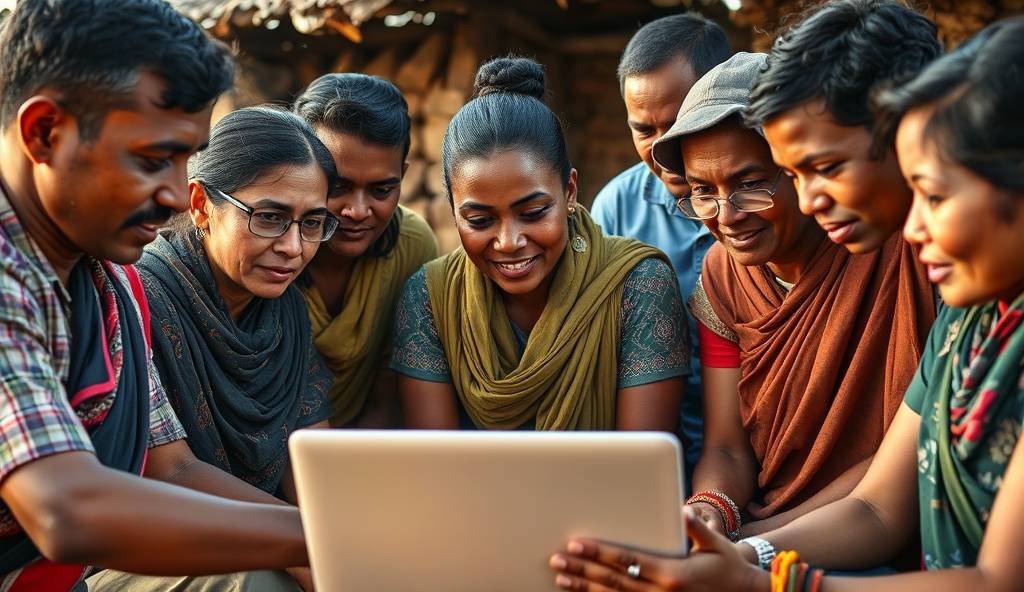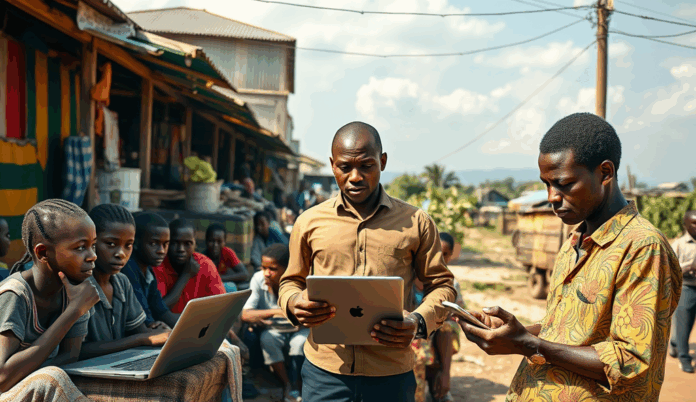Introduction to the Digital Divide in Nigeria
Nigeria’s digital divide reflects stark disparities in internet access, with only 36% of rural populations connected compared to 72% in urban areas, according to NCC 2022 data. This gap creates unequal educational opportunities, as students in Lagos benefit from online resources while those in Sokoto struggle with basic connectivity.
The digital divide in Nigeria stems from infrastructure gaps, affordability issues, and uneven digital literacy levels across regions. For instance, while private schools in Abuja use smartboards, many public schools in Kano lack functional computer labs, widening the learning gap.
Understanding these disparities is crucial before exploring solutions to bridge the technology divide in Nigeria’s education sector. The next section will define the digital divide and its specific manifestations in Nigerian classrooms.
Key Statistics

Definition and Explanation of the Digital Divide
Nigeria's digital divide reflects stark disparities in internet access with only 36% of rural populations connected compared to 72% in urban areas according to NCC 2022 data.
The digital divide refers to the unequal distribution of technology access between different groups, particularly evident in Nigeria’s urban-rural split where 72% versus 36% have internet connectivity. This gap extends beyond infrastructure to include disparities in digital skills, device ownership, and affordability of data plans, creating systemic disadvantages for marginalized communities.
In Nigerian classrooms, this manifests as private school students in Port Harcourt accessing AI-powered tutors while their public-school counterparts in Bauchi share one outdated desktop computer per 50 pupils. Such technology disparities directly impact learning outcomes, with digitally excluded students scoring 23% lower in national STEM assessments according to 2023 UBEC reports.
These inequalities stem from interconnected factors including geographical challenges, policy implementation gaps, and socioeconomic barriers that the next section will explore through Nigeria’s current digital access landscape. The widening gap calls for urgent interventions to prevent further educational marginalization.
Current State of Digital Access in Nigeria
The digital divide refers to the unequal distribution of technology access between different groups particularly evident in Nigeria's urban-rural split where 72% versus 36% have internet connectivity.
Nigeria’s digital access landscape reveals stark contrasts, with urban areas like Lagos boasting 4G coverage for 68% of residents while rural zones in states like Zamfara struggle with 12% connectivity according to NCC 2023 data. This infrastructure gap compounds existing socioeconomic disparities, leaving 43% of rural students unable to access online learning platforms during school closures.
Device ownership patterns further exacerbate inequalities, as only 19% of public school students own personal computers compared to 82% in private institutions based on a 2022 UNICEF survey. Even among mobile users, 63% of low-income families can only afford basic feature phones incapable of supporting educational apps, creating a second-layer digital exclusion.
These access barriers intersect with Nigeria’s broader digital inclusion challenges, where unreliable electricity and high data costs (averaging ₦1,200/GB) disproportionately affect marginalized learners. The next section will examine how these systemic limitations directly shape academic outcomes across Nigeria’s education system.
Impact of the Digital Divide on Nigerian Students
Nigeria's digital access landscape reveals stark contrasts with urban areas like Lagos boasting 4G coverage for 68% of residents while rural zones in states like Zamfara struggle with 12% connectivity according to NCC 2023 data.
The digital divide creates measurable learning gaps, with rural students scoring 28% lower in national STEM assessments than urban peers according to 2023 WAEC data, directly correlating with limited internet access. This disparity persists even among connected students, as those relying on mobile data complete 40% fewer online assignments than broadband users due to cost constraints.
Educational inequalities manifest in career readiness, with only 12% of public school graduates demonstrating digital workplace competencies versus 67% from elite private schools per a 2022 NUC study. The infrastructure gap particularly disadvantages female students in northern states, where cultural norms compound technological barriers to create a 35% gender gap in digital literacy.
These systemic disadvantages perpetuate intergenerational poverty cycles, as 78% of digitally excluded youth enter informal employment sectors according to NBS labor statistics. The next section will detail specific challenges Nigerian students face when navigating this uneven technological landscape.
Challenges Faced by Nigerian Students Due to the Digital Divide
The digital divide creates measurable learning gaps with rural students scoring 28% lower in national STEM assessments than urban peers according to 2023 WAEC data directly correlating with limited internet access.
Nigerian students in underserved regions face chronic device shortages, with 5 students sharing one computer in rural schools compared to 1:3 ratios in urban centers according to 2023 NCC infrastructure reports. This scarcity forces many to rely on outdated smartphones, creating a 60% completion gap for multimedia coursework between device-rich and device-poor learners.
The high cost of mobile data—consuming 30% of minimum wage earnings for 10GB monthly—forces students to prioritize essential browsing over educational downloads, worsening the rural-urban digital gap. Frequent network outages in northern states disrupt virtual classes, causing 45% of students in these areas to miss critical assessments per a 2022 UNICEF education study.
Cultural barriers exacerbate these challenges, particularly for female students in conservative regions where 62% lack parental approval for internet use according to NBS gender data. These compounded obstacles create a digital exclusion cycle that the following section will explore solutions for through government and private sector interventions.
Government and Private Sector Efforts to Bridge the Digital Divide
Emerging technologies like offline e-learning platforms and solar-powered devices are addressing Nigeria’s infrastructure gaps particularly in northern regions where only 28% of schools have stable electricity.
To address device shortages, the Nigerian government launched the Digital Nigeria Initiative in 2022, distributing 500,000 subsidized tablets to rural schools while private firms like MTN donated 200 computer labs nationwide. These efforts aim to reduce the 5:1 student-device ratio in underserved areas, though coverage gaps persist in northern states where network reliability remains low.
Telecom operators like Airtel and Glo have introduced student data plans offering 70% discounts on educational content, helping alleviate the 30% minimum wage burden for mobile data. Meanwhile, NGOs like Paradigm Initiative partner with local communities to provide digital literacy programs, particularly targeting female students in conservative regions where cultural barriers limit internet access.
These collaborative interventions show promise in breaking the digital exclusion cycle, setting the stage for emerging technologies to further narrow the gap. The next section explores how innovative tech solutions can complement these efforts to create sustainable change.
Role of Technology in Reducing the Digital Divide
Emerging technologies like offline e-learning platforms and solar-powered devices are addressing Nigeria’s infrastructure gaps, particularly in northern regions where only 28% of schools have stable electricity. Startups like uLesson leverage compressed data formats to deliver affordable educational content, complementing telecom operators’ discounted data plans for students.
AI-powered translation tools are breaking language barriers, enabling Hausa and Yoruba-speaking students to access global resources, while blockchain-based credentialing systems verify skills for rural learners with limited internet access. These innovations align with the Digital Nigeria Initiative’s device distribution, creating hybrid learning models for offline-capable communities.
As 5G networks expand to 15 cities, edge computing solutions could further reduce latency, making virtual classrooms viable for underserved areas. These technological strides set the foundation for actionable policy recommendations to sustain progress, which we’ll explore next.
Solutions and Recommendations for Nigerian Students
To maximize emerging technologies like uLesson’s compressed data formats, students should combine telecom operators’ discounted data plans with offline-capable devices distributed under the Digital Nigeria Initiative, especially in regions with only 28% electricity access. Partnering with community hubs for solar-powered charging can extend learning hours in rural areas where blockchain credentialing systems validate offline-acquired skills.
Students in 5G-enabled cities like Lagos and Abuja should advocate for edge computing solutions to reduce latency in virtual classrooms, while those in underserved areas can leverage AI translation tools to access global resources in Hausa or Yoruba. Collaborative learning groups can pool resources to afford hybrid devices, ensuring continuity during internet outages common in Nigeria’s digital inclusion challenges.
Policymakers must scale successful pilot programs, such as solar-powered e-learning centers in Kano, while students should engage in digital literacy programs to navigate infrastructure gaps. These multi-stakeholder efforts, from grassroots to government levels, will determine how effectively Nigeria bridges its rural-urban digital gap in education.
Conclusion on the Digital Divide in Nigeria
The digital divide in Nigeria remains a critical barrier to equitable education, with only 36% of rural students having reliable internet access compared to 72% in urban areas. This disparity exacerbates existing inequalities, leaving many students unable to participate in digital learning platforms like Zoom or access online resources such as JAMB past questions.
Efforts like the National Broadband Plan aim to bridge this gap, but infrastructure challenges and high data costs persist, particularly in states like Borno and Zamfara. Without urgent intervention, millions of Nigerian students risk falling further behind in an increasingly digital world.
Addressing this issue requires collaborative action from government, private sector, and communities to ensure affordable internet access and digital literacy programs reach every corner of Nigeria. The next steps must prioritize sustainable solutions that empower all students, regardless of location or socioeconomic status.
Frequently Asked Questions
Can I access educational resources without stable internet in rural Nigeria?
Use offline platforms like uLesson which offer compressed educational content that works with intermittent connectivity.
How can Nigerian students afford data for online learning with high costs?
Opt for student data plans from providers like MTN or Airtel offering 70% discounts on educational content.
What can I do if my school lacks computers for digital learning?
Join community digital hubs or advocate for device-sharing programs under the Digital Nigeria Initiative.
How can female students overcome cultural barriers to internet access in northern Nigeria?
Participate in NGO-led digital literacy programs like Paradigm Initiative that work with local communities to change perceptions.
Are there solutions for students in areas with frequent power outages to study digitally?
Use solar-powered devices and community charging stations to maintain access during electricity shortages.


